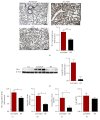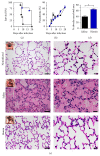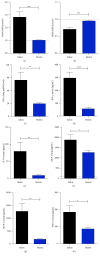Association of Heme Oxygenase 1 with Lung Protection in Malaria-Associated ALI/ARDS
- PMID: 27974865
- PMCID: PMC5126464
- DOI: 10.1155/2016/4158698
Association of Heme Oxygenase 1 with Lung Protection in Malaria-Associated ALI/ARDS
Abstract
Malaria is a serious disease, caused by the parasite of the genus Plasmodium, which was responsible for 440,000 deaths in 2015. Acute lung injury/acute respiratory distress syndrome (ALI/ARDS) is one of the main clinical complications in severe malaria. The murine model DBA/2 reproduces the clinical signs of ALI/ARDS in humans, when infected with Plasmodium berghei ANKA. High levels of HO-1 were reported in cases of severe malaria. Our data indicated that the HO-1 mRNA and protein expression are increased in mice that develop malaria-associated ALI/ARDS (MA-ALI/ARDS). Additionally, the hemin, a HO-1 inducing drug, prevented mice from developing MA-ALI/ARDS when administered prior to the development of MA-ALI/ARDS in this model. Also, hemin treatment showed an amelioration of respiratory parameters in mice, high VEGF levels in the sera, and a decrease in vascular permeability in the lung, which are signs of ALI/ARDS. Therefore, the induction of HO-1 before the development of MA-ALI/ARDS could be protective. However, the increased expression of HO-1 on the onset of MA-ALI/ARDS development may represent an effort to revert the phenotype of this syndrome by the host. We therefore confirm that HO-1 inducing drugs could be used for prevention of MA-ALI/ARDS in humans.
Conflict of interest statement
The authors declare that they have no commercial or other associations that might pose competing interests.
Figures




Similar articles
-
Could Heme Oxygenase-1 Be a New Target for Therapeutic Intervention in Malaria-Associated Acute Lung Injury/Acute Respiratory Distress Syndrome?Front Cell Infect Microbiol. 2018 May 16;8:161. doi: 10.3389/fcimb.2018.00161. eCollection 2018. Front Cell Infect Microbiol. 2018. PMID: 29868517 Free PMC article. Review.
-
Altered Lipid Composition of Surfactant and Lung Tissue in Murine Experimental Malaria-Associated Acute Respiratory Distress Syndrome.PLoS One. 2015 Dec 1;10(12):e0143195. doi: 10.1371/journal.pone.0143195. eCollection 2015. PLoS One. 2015. PMID: 26624290 Free PMC article.
-
Expression of sphingosine kinase 1 and sphingosine 1-phosphate receptor 3 in malaria-associated acute lung injury/acute respiratory distress syndrome in a mouse model.PLoS One. 2019 Sep 4;14(9):e0222098. doi: 10.1371/journal.pone.0222098. eCollection 2019. PLoS One. 2019. PMID: 31483837 Free PMC article.
-
Role of cuproptosis in mediating the severity of experimental malaria-associated acute lung injury/acute respiratory distress syndrome.Parasit Vectors. 2024 Oct 19;17(1):433. doi: 10.1186/s13071-024-06520-1. Parasit Vectors. 2024. PMID: 39427197 Free PMC article.
-
Vascular endothelial growth factor and related molecules in acute lung injury.J Appl Physiol (1985). 2004 Nov;97(5):1605-17. doi: 10.1152/japplphysiol.00202.2004. J Appl Physiol (1985). 2004. PMID: 15475552 Review.
Cited by
-
Integration of multiomics analysis to reveal the major pathways of vitamin A deficiency aggravates acute respiratory distress syndrome in neonatal rats.Sci Rep. 2023 Dec 19;13(1):22643. doi: 10.1038/s41598-023-47664-x. Sci Rep. 2023. PMID: 38114510 Free PMC article.
-
Inhibition of Heme Oxygenase-1 by Zinc Protoporphyrin IX Improves Adverse Pregnancy Outcomes in Malaria During Early Gestation.Front Immunol. 2022 May 10;13:879158. doi: 10.3389/fimmu.2022.879158. eCollection 2022. Front Immunol. 2022. PMID: 35619717 Free PMC article.
-
Personalized medicine using omics approaches in acute respiratory distress syndrome to identify biological phenotypes.Respir Res. 2022 Nov 19;23(1):318. doi: 10.1186/s12931-022-02233-0. Respir Res. 2022. PMID: 36403043 Free PMC article. Review.
-
Diannexin Can Ameliorate Acute Respiratory Distress Syndrome in Rats by Promoting Heme Oxygenase-1 Expression.Mediators Inflamm. 2021 Apr 9;2021:1946384. doi: 10.1155/2021/1946384. eCollection 2021. Mediators Inflamm. 2021. PMID: 33927569 Free PMC article.
-
Heme Oxygenase-1 Reduces Sepsis-Induced Endoplasmic Reticulum Stress and Acute Lung Injury.Mediators Inflamm. 2018 Jun 14;2018:9413876. doi: 10.1155/2018/9413876. eCollection 2018. Mediators Inflamm. 2018. PMID: 30013453 Free PMC article.
References
-
- WHO. World Malaria Report 2015. Geneva, Switzerland: World Health Organization; 2015.
-
- Centers for Disease Control and Prevention-Malaria. http://www.cdc.gov/malaria/about/disease.html.
-
- Mohan A., Sharma S. K., Bollineni S. Acute lung injury and acute respiratory distress syndrome in malaria. Journal of Vector Borne Diseases. 2008;45(3):179–193. - PubMed
MeSH terms
Substances
LinkOut - more resources
Full Text Sources
Other Literature Sources
Medical

